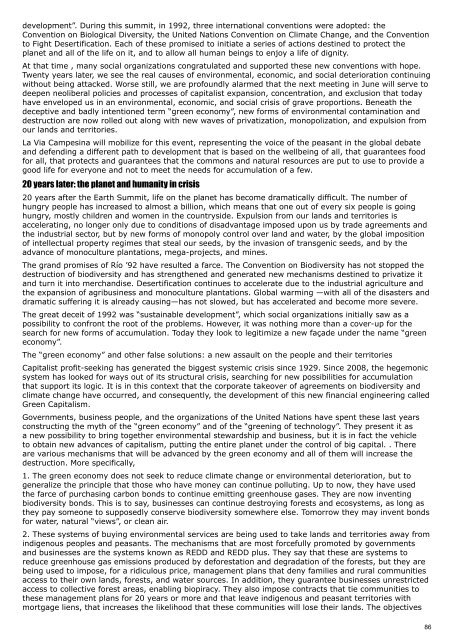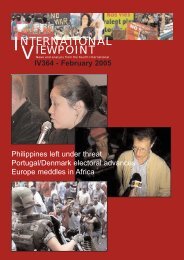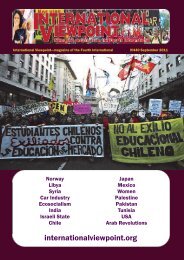Here - International Viewpoint
Here - International Viewpoint
Here - International Viewpoint
You also want an ePaper? Increase the reach of your titles
YUMPU automatically turns print PDFs into web optimized ePapers that Google loves.
development”. During this summit, in 1992, three international conventions were adopted: the<br />
Convention on Biological Diversity, the United Nations Convention on Climate Change, and the Convention<br />
to Fight Desertification. Each of these promised to initiate a series of actions destined to protect the<br />
planet and all of the life on it, and to allow all human beings to enjoy a life of dignity.<br />
At that time , many social organizations congratulated and supported these new conventions with hope.<br />
Twenty years later, we see the real causes of environmental, economic, and social deterioration continuing<br />
without being attacked. Worse still, we are profoundly alarmed that the next meeting in June will serve to<br />
deepen neoliberal policies and processes of capitalist expansion, concentration, and exclusion that today<br />
have enveloped us in an environmental, economic, and social crisis of grave proportions. Beneath the<br />
deceptive and badly intentioned term “green economy”, new forms of environmental contamination and<br />
destruction are now rolled out along with new waves of privatization, monopolization, and expulsion from<br />
our lands and territories.<br />
La Via Campesina will mobilize for this event, representing the voice of the peasant in the global debate<br />
and defending a different path to development that is based on the wellbeing of all, that guarantees food<br />
for all, that protects and guarantees that the commons and natural resources are put to use to provide a<br />
good life for everyone and not to meet the needs for accumulation of a few.<br />
20 years later: the planet and humanity in crisis<br />
20 years after the Earth Summit, life on the planet has become dramatically difficult. The number of<br />
hungry people has increased to almost a billion, which means that one out of every six people is going<br />
hungry, mostly children and women in the countryside. Expulsion from our lands and territories is<br />
accelerating, no longer only due to conditions of disadvantage imposed upon us by trade agreements and<br />
the industrial sector, but by new forms of monopoly control over land and water, by the global imposition<br />
of intellectual property regimes that steal our seeds, by the invasion of transgenic seeds, and by the<br />
advance of monoculture plantations, mega-projects, and mines.<br />
The grand promises of Río ’92 have resulted a farce. The Convention on Biodiversity has not stopped the<br />
destruction of biodiversity and has strengthened and generated new mechanisms destined to privatize it<br />
and turn it into merchandise. Desertification continues to accelerate due to the industrial agriculture and<br />
the expansion of agribusiness and monoculture plantations. Global warming —with all of the disasters and<br />
dramatic suffering it is already causing—has not slowed, but has accelerated and become more severe.<br />
The great deceit of 1992 was “sustainable development”, which social organizations initially saw as a<br />
possibility to confront the root of the problems. However, it was nothing more than a cover-up for the<br />
search for new forms of accumulation. Today they look to legitimize a new façade under the name “green<br />
economy”.<br />
The “green economy” and other false solutions: a new assault on the people and their territories<br />
Capitalist profit-seeking has generated the biggest systemic crisis since 1929. Since 2008, the hegemonic<br />
system has looked for ways out of its structural crisis, searching for new possibilities for accumulation<br />
that support its logic. It is in this context that the corporate takeover of agreements on biodiversity and<br />
climate change have occurred, and consequently, the development of this new financial engineering called<br />
Green Capitalism.<br />
Governments, business people, and the organizations of the United Nations have spent these last years<br />
constructing the myth of the “green economy” and of the “greening of technology”. They present it as<br />
a new possibility to bring together environmental stewardship and business, but it is in fact the vehicle<br />
to obtain new advances of capitalism, putting the entire planet under the control of big capital. . There<br />
are various mechanisms that will be advanced by the green economy and all of them will increase the<br />
destruction. More specifically,<br />
1. The green economy does not seek to reduce climate change or environmental deterioration, but to<br />
generalize the principle that those who have money can continue polluting. Up to now, they have used<br />
the farce of purchasing carbon bonds to continue emitting greenhouse gases. They are now inventing<br />
biodiversity bonds. This is to say, businesses can continue destroying forests and ecosystems, as long as<br />
they pay someone to supposedly conserve biodiversity somewhere else. Tomorrow they may invent bonds<br />
for water, natural “views”, or clean air.<br />
2. These systems of buying environmental services are being used to take lands and territories away from<br />
indigenous peoples and peasants. The mechanisms that are most forcefully promoted by governments<br />
and businesses are the systems known as REDD and REDD plus. They say that these are systems to<br />
reduce greenhouse gas emissions produced by deforestation and degradation of the forests, but they are<br />
being used to impose, for a ridiculous price, management plans that deny families and rural communities<br />
access to their own lands, forests, and water sources. In addition, they guarantee businesses unrestricted<br />
access to collective forest areas, enabling biopiracy. They also impose contracts that tie communities to<br />
these management plans for 20 years or more and that leave indigenous and peasant territories with<br />
mortgage liens, that increases the likelihood that these communities will lose their lands. The objectives<br />
86









